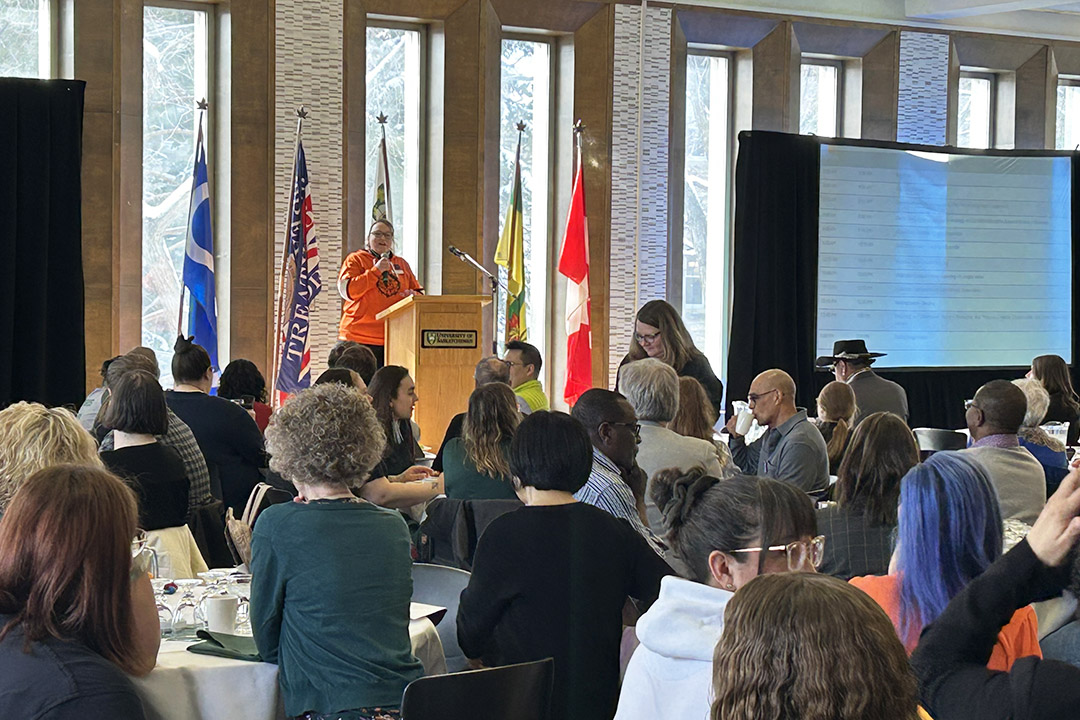
Let’s fly up together: Stewarding the Indigenous Strategy at USask
The University of Saskatchewan’s (USask) fifth bi-annual ohpahotân | oohpaahotaan symposium champions stewardship of the plan.
By Ashley DopkoOn April 19, 2024, the fifth bi-annual ohpahotân | oohpaahotaan symposium was held on the University of Saskatchewan (USask) campus at Marquis Hall, with more than 250 people in attendance.
Dr. Keith Willoughby (PhD), dean of Edwards School of Business at USask and member of the mistatimok committee spoke to the meaning of mistatimok which translates to “horses” and the concept of “working together in Saulteaux.” The meaning behind this refers to when horses are harnessed together to a wagon, and they must work together in concert with each other. “It’s important that we help one another to work together, but not just with our heads but with our hearts,” said Willoughby.
In summer 2021, the university was gifted ohpahotân | oohpaahotaan the Indigenous Strategy and over the past two years considerable consultation and growth has taken place in colleges and units across campus. Dr. Angela Jaime (PhD) and her team at the Office of the Vice-Provost, Indigenous Engagement have been sharing the plan and guiding the USask community towards the fulfilment of the seven commitments – safety, wellness, stewardship, representation, right relations, creation, and renewal.
The focus of this year’s symposium was stewardship, looking at how the university has made strides in shepherding the plan, and explaining that all members of the USask community must look to themselves and bring ohpahotân | oohpaahotaan to the forefront of their own work.
There are a number of policies and projects that demonstrate good stewardship, and were discussed in the symposium, such as deybwewin | taapwaywin | tapwewin and the oyateki project. One of the important initiatives that was discussed was the adoption of the smudge and ceremony policy.
“We passed the smudge and ceremony policy in June 2023,” said Carson Magnuson, strategic officer, Indigenous Engagement. “So now all spaces on campus are smudge and ceremony safe. It is something that went through a lot of careful consideration and consultation through the Indigenous Advisory Circle. By increasing physical spaces for Indigenous culture practices, this policy speaks to transformative decolonization.
“As stewards we need to be asking, how do we create a community that supports all people on campus? Ensuring that USask is a smudge and ceremony safe space removes barriers to Indigenous students, staff and faculty from practicing their culture.”
This change is moving USask in a more intentional direction. A new report detailing this work and capturing where USask is in the process of stewardship, is now available on the Office of the Vice-Provost, Indigenous Engagement website.
“This report is meant to give our campus community an account of the past leading to the gifting of the Indigenous strategy, a snapshot of our present status towards realizing the Indigenous strategy, and a glimpse at what our future will be once we have embedded ohpahotân | oohpaahotaan throughout USask,” said Jaime. “This work is not easy. It demands our attention, respect, and love.”
“I challenge you to create safe and accountable spaces in your own units,” said Jaime. “Engage with the Office of the Vice-Provost, Indigenous Engagement. It doesn’t matter how big of small your group is, we are here to support and walk with you on this journey.”
Participants spent the day beading red dress pins courtesy of Beading with Aunties in preparation for the May 3 event in The Bowl for people to show their support for ending violence against Indigenous women, girls, and 2SLGBTQIA+ people.
The day came to a close with Elders Harvey Thunderchild and Joseph Naytowhow ending it in a good way, bringing their wisdom, knowledge and song to the group.
The Office of Vice-Provost will be hosting the mâmowi âsohtệtân Internal Truth and Reconciliation Forum on May 14, 2024, from 12-1:30 pm for a constructed conversation about a book by Andrew Stobo Sniderman and Douglas Sanderson, Valley of the Birdtail: An Indian Reserve, A White Town, and the Road to Reconciliation. For ways to access the book, contact OVPIE at indigenous@usask.ca.
Together, we will work towards Truth and Reconciliation. We invite you to join by supporting Indigenous achievement at USask.
Article re-posted on .
View original article.

